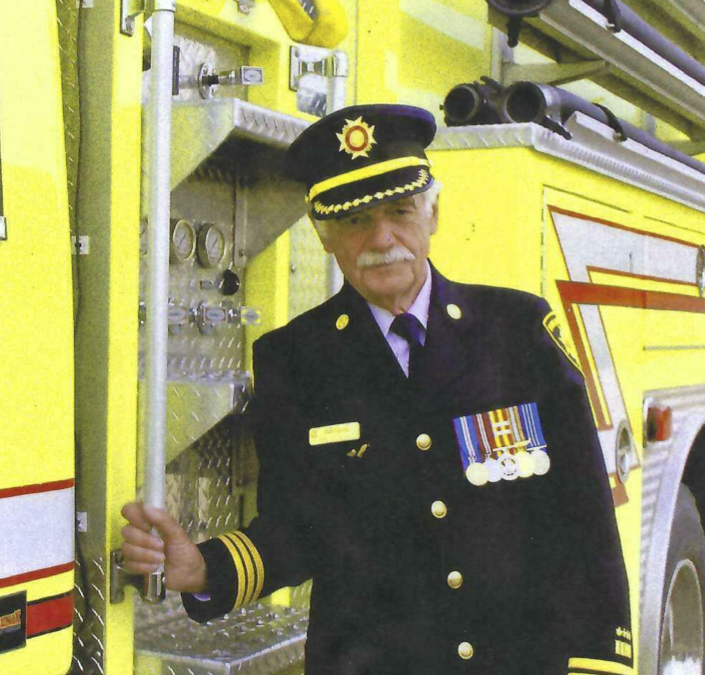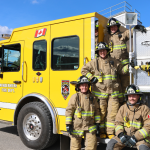When facing the force of fire, firefighters have long been our communities’ front line of defence. Over the years, the fire service has undergone a remarkable transformation, adapting to changing environments, embracing technological innovations, and expanding its role beyond traditional firefighting.
To get more insight into how the fire service has changed over the years, we interviewed Chief Bill Purdy, a fire chief with an impressive 60-year career in the fire service. Chief Purdy’s wealth of experience provides valuable insight into the evolution of the fire service. Join us as we explore the significant transformations, challenges, and technological advancements that have revolutionized the fire service.
Meet Fire Chief Bill Purdy: Pioneering Fire Protection in Wabamun
Fire Chief Bill Purdy’s journey in the fire services began in 1961 when he was hired as an engineer to work at the power plant in Stony Plain, Alberta’s municipal district (M.D.). At that time, the hamlet of Wabamun had no fire protection, and with the increasing population due to the power plant’s establishment, concerns about fire safety grew. Recognizing the urgency, Chief Purdy and colleagues from Calgary Power and the local mine formed a committee to advocate for fire protection in the area.
Their dedication came to fruition when the M.D. of Stony Plain approved a plan to expand fire protection to all hamlets within its jurisdiction over the next few years. Wabamun was the first to be selected, marking the beginning of its fire service in 1964. At its inception, the department had 22 members, operating with an open boundary encompassing the entire M.D.
As the fire department grew, so did the coverage area. Fire equipment was introduced to various hamlets, and agreements were established with neighbouring towns and villages, enhancing the fire protection network. The department received its first fire truck in 1964, and rigorous training from the Fire Commissioner’s Office ensured the firefighters were well-prepared for their duties.
Chief Purdy and his team were committed to building a strong foundation for fire protection in Wabamun. A new fire hall was constructed with limited resources, costing only $6,800.
Overcoming Challenges: Equipment and Training
Throughout the history of the fire service, overcoming challenges has been a driving force in shaping modern firefighting. However, the journey toward progress wasn’t without its hurdles.
Chief Purdy shares a glimpse of the early days: “Back then, our personal protection equipment (PPE) left much to be desired. We were equipped with rubber boots, barely reaching our hips and subpar helmets. Our only form of protection from the elements was a black leather raincoat. Breathing apparatus was unheard of. We first acquired three sets of the old steel bottles, which were quite a challenge to carry around, in 1969. The oxygen in those bottles would last about 20 minutes, depending on the situation’s intensity. Over the years, the breathing apparatus has, of course, improved greatly.”
It’s incredible to think of the obstacles early firefighters faced with such limited gear. However, the department continuously sought to improve its capabilities.
Harnessing Technology for a Safer Fire Service
In the ever-changing landscape of the fire service, technology has played a pivotal role in revolutionizing the way we approach firefighting. From improved communication systems to state-of-the-art equipment, technological advancements have been a driving force in enhancing firefighter safety and effectiveness.
Chief Purdy reflects on the transformative journey: “Throughout my tenure, there have been significant technological advancements in the fire service. Being closely affiliated with the Alberta Fire Chiefs Association and the National Fire Protection Association allowed me to be part of the operation, gaining more knowledge about the latest standards and practices.”
One of the most notable changes has been in communication systems. Gone are the days of siren-based alerts. Instead, this was moved to a pager system for more efficient and precise dispatches. More recently, the introduction of mobile apps has further streamlined communication, providing firefighters with real-time information at their fingertips. With these advancements, response times have improved, enabling firefighters to reach the scene swiftly and effectively.
Chief Purdy makes a note of his experience in how communication systems have changed by noting: “In 1975, the department received our first pager for response, and full-time dispatch occurred in 1989 when Parkland County officially opened the 911 call center in Stony Plain, dispatching for several fire department and municipalities in Alberta. The center recently moved to the new fire hall in Wabamun’.”
Moreover, innovative PPE has become a mainstay in modern firefighting. Flame-resistant gear and thermal imaging cameras provide added protection and situational awareness, enabling firefighters to navigate hazardous environments more safely and efficiently.
Chief Purdy emphasizes the positive impact of these technological advancements: “The fire service has come a long way, both in terms of technological advancements and strategic planning. The commitment to embracing change and investing in the latest technologies has enhanced our efficiency and improved the safety of our firefighters and the communities we serve.”
Building the Future: Training and Recruitment in the Fire Service
Chief Purdy next reflected on the evolution of recruitment and training practices over the years. The fire service has transitioned from an ad-hoc approach to a more structured and standardized system. The Alberta Fire Chiefs Association’s proactive efforts in developing recruitment and retention strategies have proven instrumental in attracting and retaining passionate firefighters.
During my tenure as the executive director, we recognized the need for strategic improvements. Thus, in 2011, we successfully obtained a grant to conduct a thorough study on recruitment and retention. Through collaboration with a consultant, we identified essential factors that have since shaped our training initiatives. This program was piloted in several Alberta municipalities, including ours, and its success gained momentum. Thanks to our friend Peter Krich, the chief at Camrose, the program garnered interest from the Canadian Fire Chiefs Association and even expanded into the United States. Today, the program continues to thrive, empowering municipalities and fire departments with a deeper understanding of their needs.
Our study revealed a crucial insight: Firefighter retention increases significantly if individuals remain with the department for at least five years. However, in some small Alberta towns, young recruits eager to serve face challenges finding work within the community. As they seek employment elsewhere, they reluctantly leave the department.”
Looking to the Future
As we look to the future of the fire service, we recognize that new challenges will arise. Climate change, urbanization, and technological advancements will demand a flexible approach from our industry.
With extensive experience in the fire service and his involvement with the Alberta Fire Chiefs Association, Chief Purdy emphasizes the ongoing changes and advancements the fire service will face. He highlights the importance of continual adaptation to new technologies, enhancing training programs, and the increasing need for collaboration and coordination in emergency response, particularly in the face of wildfire incidents.
Chief Purdy’s passion for the fire service extends beyond his active years, as he undertakes documenting the history of the fire services in Parkland County. Recognizing the value of capturing historical information, Chief Purdy aims to expand this initiative to preserve the province-wide history of the fire service for future generations.
Summary
The fire service’s journey of transformation and adaptation has been shaped by the dedication and resilience of individuals like Chief Bill Purdy, whose remarkable 60-year career reflects the fire service’s evolution.
The fire service’s progression from rudimentary equipment to cutting-edge technology showcases its commitment to firefighter safety and efficiency. Advancements in communication systems, innovative personal protective gear, and the integration of mobile apps have revolutionized firefighting practices, allowing firefighters to respond to emergencies swiftly and effectively.
The strategic evolution of recruitment and training practices has further bolstered the fire service’s capabilities. Standardized training programs and thoughtful recruitment initiatives have proven essential in attracting dedicated firefighters and ensuring their retention within the department.
As we look to the future, the fire service must remain adaptable to meet new challenges head-on. Climate change and technological advancements will demand ongoing innovation and collaboration from our industry.
Looking for more? Sign up for your free copy of FireWatch. A monthly digital newsletter where we bring the latest industry news to your fingertips. The articles we share have caught our attention, and we will keep you in the “know”!
Sign Up Now





